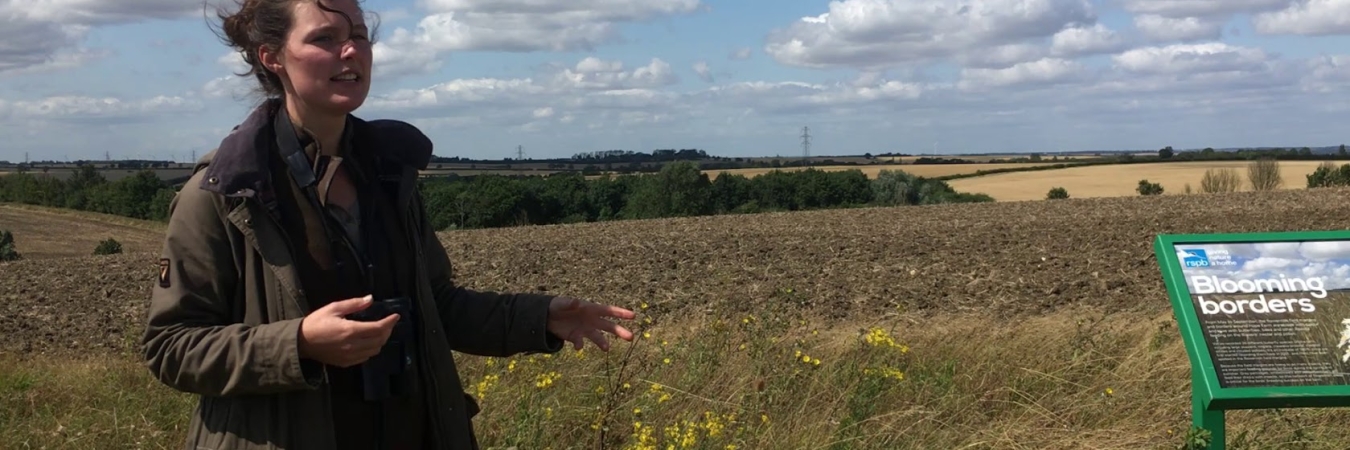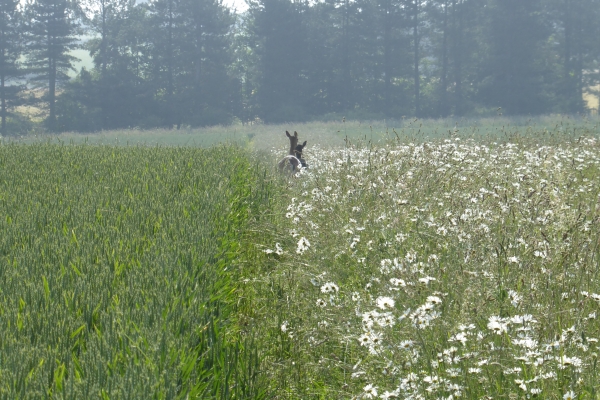Georgie Bray
RSPB Hope Farm, Knapwell, Cambridgeshire
(First published: November 2019. See November 2022 update below)
The RSPB bought Hope Farm, a conventional arable farm in Cambridgeshire, in 2000, with the aim of developing and trialling farming techniques which produce food cost effectively and benefit wildlife at the same time. The aim was to monitor the biodiversity change as a result of integrating biodiversity conservation into a conventional profitable farmed system. By creating key habitats such as skylark plots, wild bird cover, nectar flower mixtures and floristic grass margins and implementing true integrated pest management (IPM), we wanted to demonstrate a working conventional arable farm with diversity, and without effecting the profitability of the site. The whole time of RSPB’s ownership has been a useful learning curve, where experiences have helped develop RSPB messages and advice to farmers, government and the general public. The cropping is under a shared farm contract agreement, and environmental management contracted out to Martin Lines, a local farmer.
From 2000 to 2005 we followed the same historical cropping practice, similar to other farms in the area. The farm followed a simple three year rotation of first and second wheats with oilseed rape (OSR). The rotation has since evolved to regularly include seven different crops. This helps us to control weed problems, reduce our overall input costs and so reducing risk, whilst reducing our carbon footprint. Rotations form a crucial part of our IPM programme too. We now grow OSR, winter wheat, spring beans, winter and spring barley, winter and spring beans and spring millet.

The spring crops have helped support breeding farmland birds in decline across the UK. The spring barley is a much more productive crop for skylark breeding all through the season, whilst the beans have been a favoured by lapwings (see above) and yellow wagtail this year, as well as being full of pollinating and natural enemy insects. We have maintained wheat yields since 2000 and maintained profitability. OSR and field bean yields compare favourably with similar sized farms in eastern England.
Alongside the arable land, there is permanent pasture which is grazed by horses and sheep.
We use the Mid Tier Countryside Stewardship (CS) scheme to the advantage of both ourselves and wildlife. In 2007, Hope Farm joined the Entry Level Stewardship scheme which changed to the Mid Tier scheme in 2018. These paid services can also provide us with other less obvious benefits like soil protection, water protection, pollinator and natural pest control services, and a better more economically savvy use of the marginal areas on the farm.
Through the scheme, research projects, and voluntarily we manage:
- 4.59 hectares (ha) of low input grassland
- 0.12 ha of beetle banks
- 25 skylark plots
- 13km of hedgerow managed for wildlife
- 4.4 ha of flower-rich margins
- 4.2 ha of winter bird food
- 4.3 ha of nectar flower mix
- 14.8 ha of cultivated areas for wild arable plants
- 1.775 tonnes of supplementary feed through winter
Putting marginal or lower-yielding areas of land (such as corners of fields) into CS, where we would make less or no profit if it was farmed conventionally helps to show that both farmers and nature can thrive in the same environment. We try to balance good value for us with good value for the funders of CS, making the best use of each part of the land we manage.
Farmland birds have increased largely thanks to the agri-environment options in place at Hope Farm. Our CS scheme is designed to increase the area of in-field nesting habitat, winter seed food and insect-rich foraging habitat. We have used the farm to find new ways of helping birds to breed successfully on commercial farmland as well; options like the skylark plot were first trialled at Hope Farm.
Methods we have been investigating to conserve skylarks, corn buntings, turtle doves and other species have progressed to influence policy for the better. Between 2000 and 2011, the farmland bird index on Hope Farm tripled, largely due to us implementing the Farm Wildlife partnership 6-point plan.
After demonstrating that you can have an abundance of wildlife with a profitable arable farm, we’ve progressed to look now at more large-scale research for improved soil, crops and wildlife habitat without taking land out of production. We’ve been looking into cover crops and compost as viable ways to improve habitat for farm wildlife and soil health, as well as participating in the ASSIST project. Both projects take up about a third of the farm each.
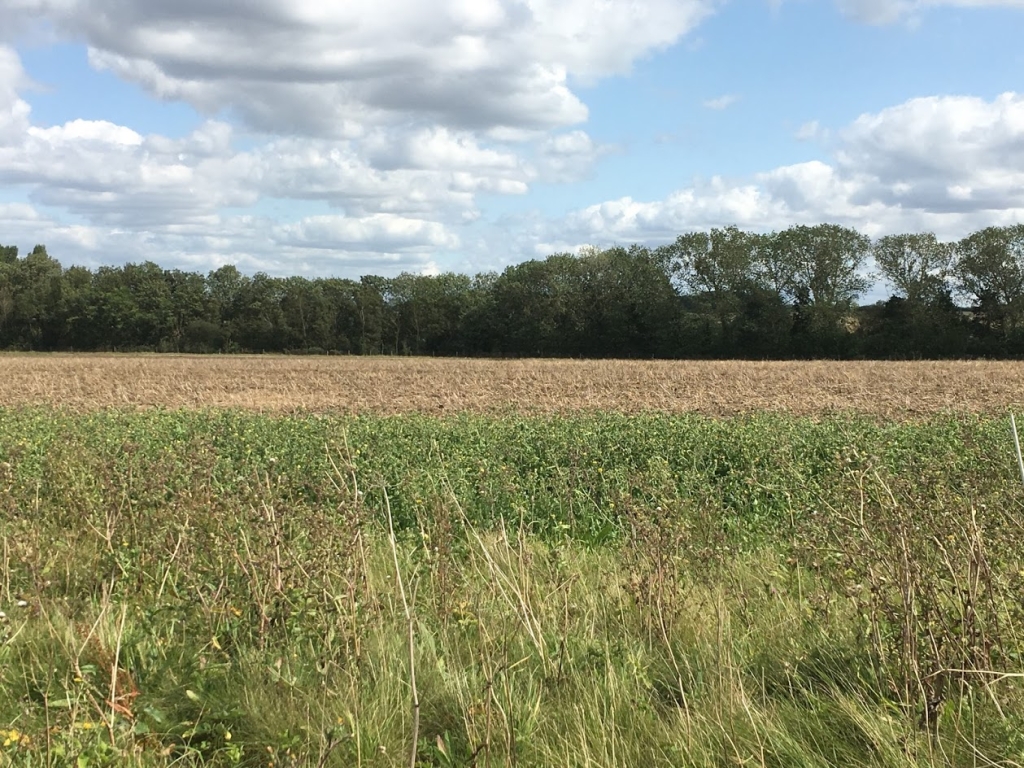
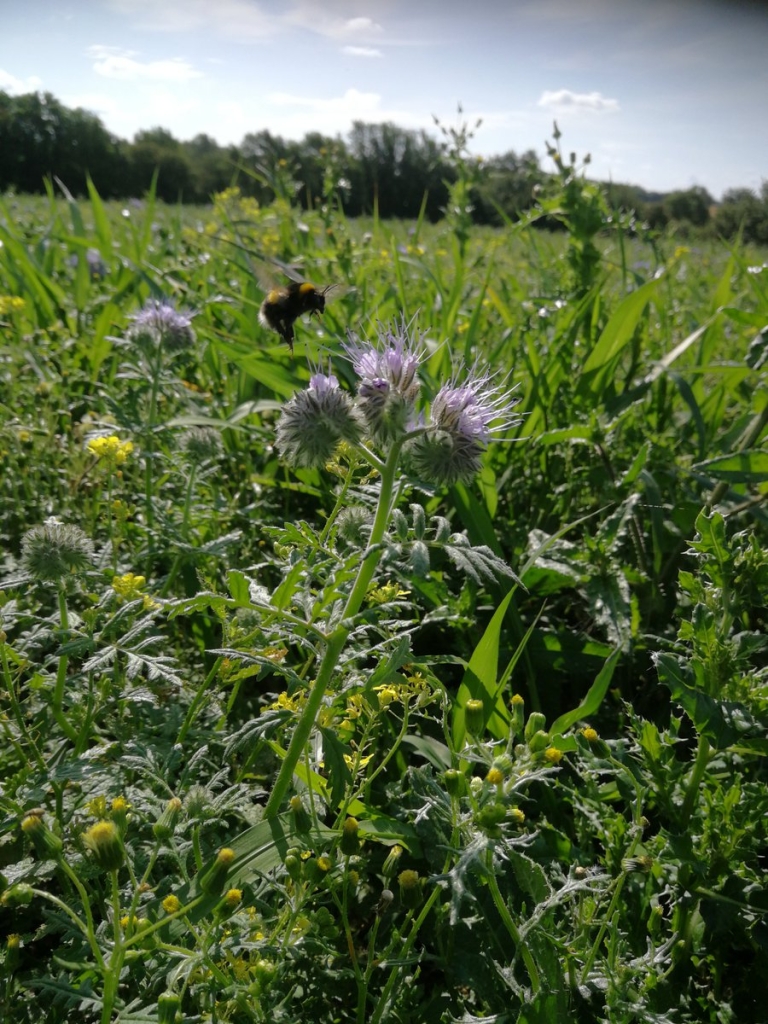
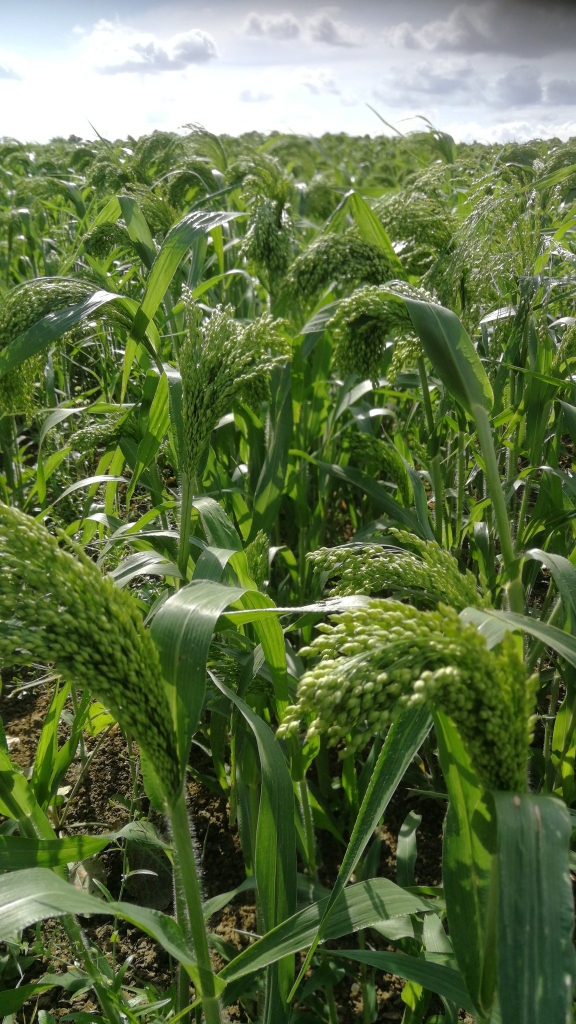
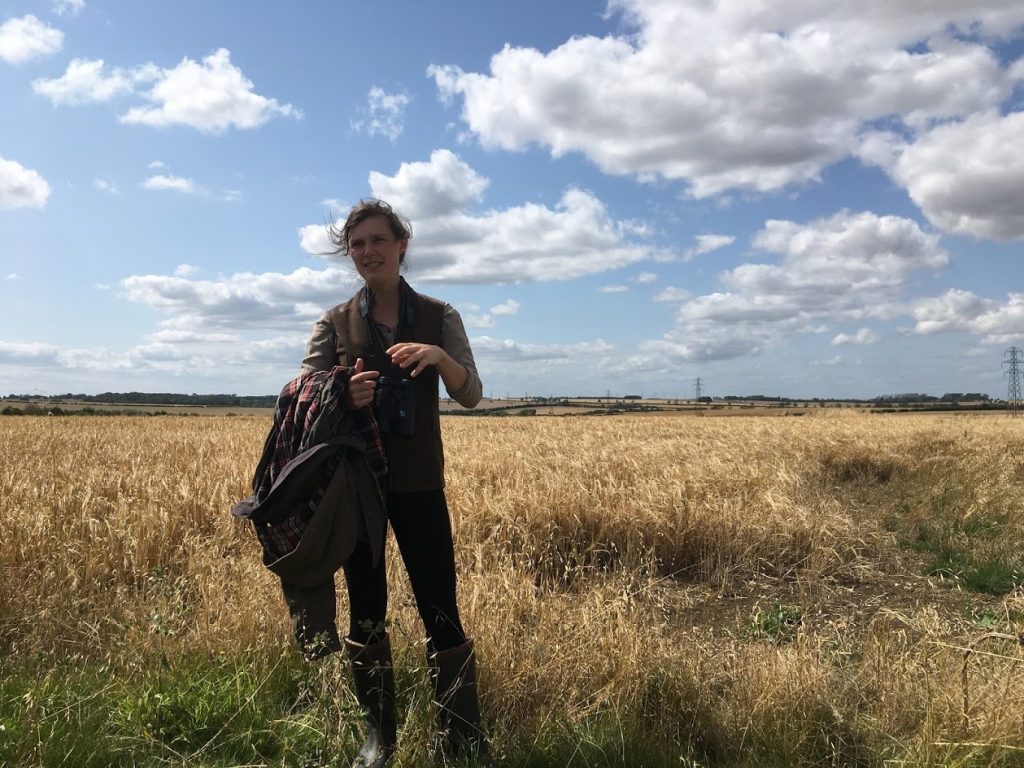
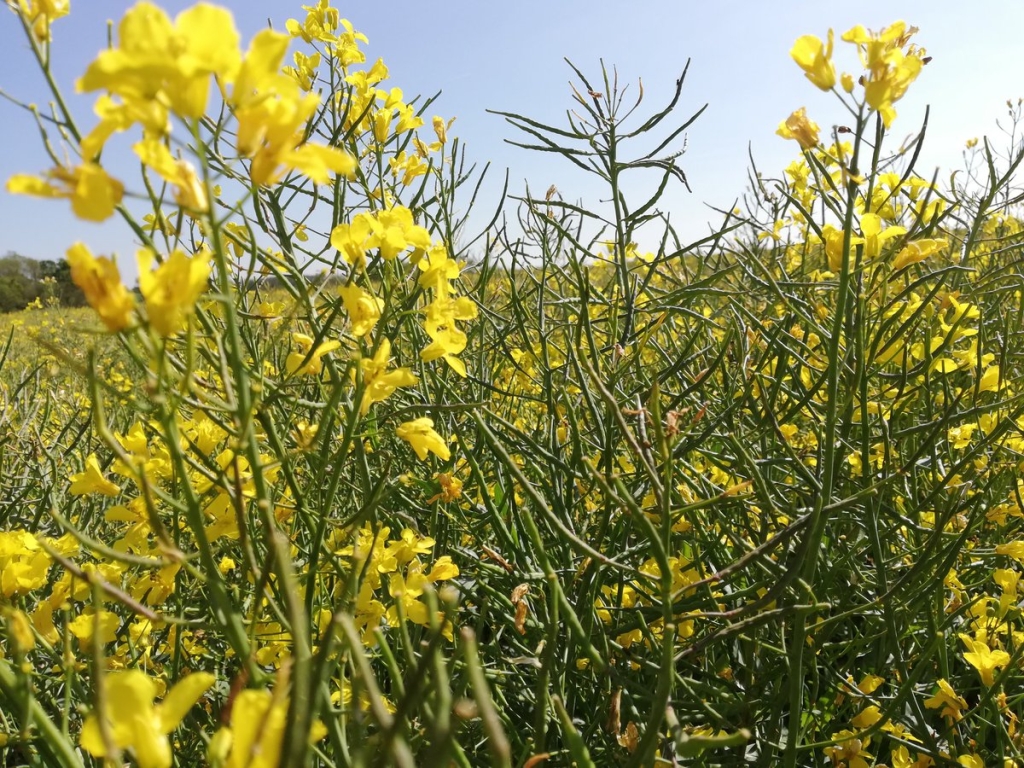
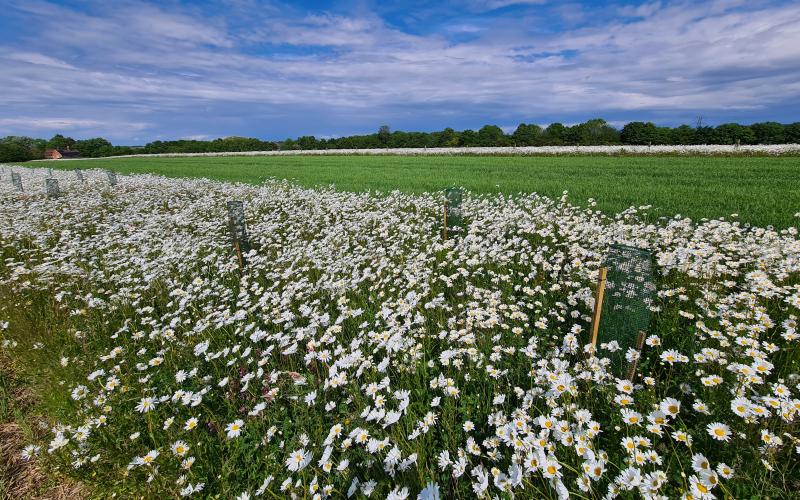

Sustainability in practice
Wildlife monitoring, using cover crops and compost to benefit soil health and biodiversity, and pollination and pest control using wildflower margins
Wildlife monitoring
We use a series of nationally recognisable survey methods which allow us to produce long-term population trends for birds, butterflies and bumblebees and to look at how they have responded to the wildlife farming measures. Our 2018 farmland bird index was 2 times greater than the baseline. This rise has been driven by helping species which have declined nationally, such as grey partridge, skylark, linnet and yellowhammer. In 2018, common blue, brown argus and small copper butterflies were recorded at being at record levels, and we recorded the equivalent to 1 bumblebee every 17 metres, compared to 1 every 344 metres on a control farm without wildlife-friendly farming measures.
Using cover crops and compost to benefit soil health and biodiversity
We are carrying out a long term cover crop and green compost field-scale trials across 70 hectares of the land – monitoring benefits to soil structure and health and biodiversity. We are analysing soil microbial functional diversity, invertebrate and bird diversity, organic carbon and labile nitrogen, crop yield, black-grass, and the winter and summer vegetation structure.
We are looking at how birds use cover crops to overwinter and hope that by demonstrating that cover crops and compost provide wider benefits to wildlife, we will strengthen the case for supporting farmers wishing to use these methods on their land. By using direct drilling as part of this experiment, we are helping worms and invertebrates in the soil to thrive, which means more food for birds, reduced use of fuel and therefore our carbon footprint, and saving us money by reducing our man ours and machinery wear and tear.
During the first winter of monitoring the cover crops we found that many more birds used these areas compared to our control plots. We are now looking into what kinds of birds and what they are using them for.

As part of this trial we are spreading 30 tonnes of compost a hectare – it is expensive but has been found to improve soil health and the grown crop for up to 5 years after ceasing application. Organic matter that we have increased on these trial plots is known to help hold the water in the soil in the drier months, whilst improving drainage, resilience, and crop establishment. Composted plots on Hope Farm have shown a significant increase in earthworm abundance and diversity so far.
We have shown in our research that incorporating organic matter will increase soil biodiversity and give more bird food as well as improving crop performance, so we’ve started to use similar methods on the rest of the farm.
Pollination and pest control using wildflower margins
We are participating in the 5-year project ASSIST (Achieving Sustainable Agricultural Systems), which is run by Rothamsted Research and the Centre for Ecology & Hydrology and is looking at sustainable intensification using in-field wildflower strips.
Research has found that wildflower margins can enhance pollinator and pest control services in an intensively farmed field, but this usefulness has largely only been exploited using margins that frame fields. Research behind the ASSIST trial has shown that when you have a wildflower margin next to a bean crop that requires pollination, you can increase yields by up to 25% up to 50m in the field, which is a direct benefit of providing a home for natural enemies of pests and pollinators.
At Hope Farm and 15 other farms, researchers will investigate the effects of pollinator strips going across the middles of fields in relation to soil health, the promotion of crop pollinators, and their impact on crop pest predators. This Natural Environment Research Council and Biotechnology and Biological Sciences Research Council-funded project hopes to provide vital evidence to shape and influence future policy and promote innovations in sustainable agriculture across a wider scale.
Diverse wildflower margins can be expensive, but they are a long-term gain. With wildflower mixes, once established you can keep them there for 15 years or more. They are not as easy and take a few years to get established but you get a habitat that has a diversity of flowers and grasses that suits hundreds of beneficial insects. Plants such as knapweed, vetches, and oxeye daisies are all different shapes and sizes which suit everything from your long-tongued bees and butterflies to insects that like to land on flat surfaces like the hoverflies. Having grass in the mix mean that marbled white butterflies, grasshoppers and crickets are also going to find it an attractive habitat.
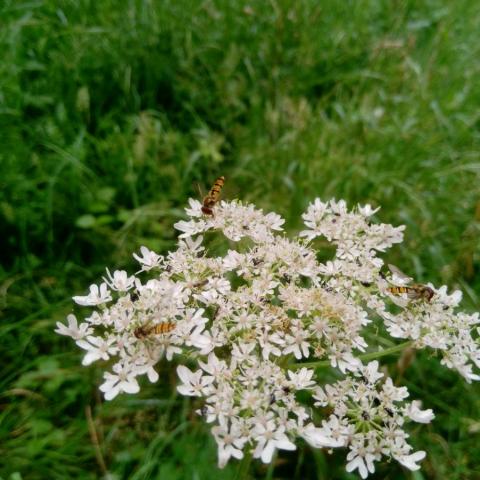
Here we’re on heavy clay land, so have to ensure we get conditions just right to stand a chance of establishing a good margin. You need to start preparations 6 months to a year before you put the seed in. It is crucial to give plenty of time to establish a stale seedbed, with a fine tilth, before waiting for warm moist soil conditions. When seeds start to establish you will get annual weeds coming up. We have a margin for an ASSIST trial that we have mown every 3 weeks from about April time, and now at the end of it’s first season, are starting to look at the kind of margin we want around our fields. Next year it should be ready to undergo normal management where we mow in the autumn, turn the cuttings, let the seed with flowers drop and then bale it, which keeps the open sward and ensures that flowers aren’t out-competed by grass.
*November 2022 update*
Things at Hope farm have moved on considerably since we wrote this farmer profile so we thought it was time for an update! The cover crop and compost trial and the ASSIST trial, previously mentioned, are coming towards their end. Data analysis awaits and hopefully we will see interesting findings coming out of these soon. Key findings already in the ASSIST trial has shown improvements to slug control with the input of wildflower margins and habitat provision for invertebrates, earthworms, and some birds with the use of cover crops and compost.
We have also introduced two new trials (see the short video clips below):
An insecticide-free oilseed rape (OSR) trial – linked with Rothamsted Research again. We have used companion crops and traps crops (Tyfon turnip stubble) in order to get a good crop off the ground whilst investing in long term benefits for the field, rather than inputs that compromise farmland ecosystem function. The companion crop did a great job of hiding the OSR at its most vulnerable stage, and by diversifying the living roots in the field, we have enhanced the soil resilience to support the crop. The tall phacelia element also seemed to help deter pigeons in late winter from feeding on the crop, whilst grey partridge and other species were thriving in it. The trap crop showed very promising early results; tolerable damage in the OSR crop, strong plants, and four times as many flea beetle larvae in the trap crop compared to the OSR. The trap crop strips, planted every 60m, were then mulched in February to avoid larvae pupating. Harvest will tell if the trial has been as successful this year and we will be looking to repeat these results over the next few years to see if this provides reliable control.
Agroforestry – we also have another very exciting trial in the form of our new agroforestry field. Here we have planted over 1,000 trees into 6m alleys in an 11 hectare field. Alleys are separated by 24m of arable cropping. We have planted a mixture of native broadleaves for wind protection, and apple and cobnut trees for production. We have a long-term monitoring plan in place to look at how this system really works for our farm both practically and economically, our wildlife, and our carbon sequestration, and are taking extensive measurements in all three areas to keep track of how these things change over time, and in comparison, to our control field.
Aside from trials, we are still developing how we assess and manage the farm year-on-year. We are focusing more and more on our soils and how we can support a healthy ecosystem below ground. In recent years this meant adding more types of organic matter, and reducing cultivations towards no till. That also means soil testing before adding inorganic nitrogen, and we look to see what more we can do in ways that still make business sense, sense for the crops, and the wider environment. Our hedgerow management is getting increasingly diverse as we try new tools and techniques, which have involved knocking back a few of the bigger hedges with a sheer grab to re-establish the regenerative parts on the edges of hedgerows that are some of the most useful parts of a hedge for nature.
Our cropping rotation continues to diversify as we begin to look at intercropping, and companion cropping more frequently, as well as our well established cover cropping practice. We are increasingly more aware of our carbon footprint and are actively looking at ways we can reduce what we emit and sequester some back where possible. Of course, our awkward corners and margins are still performing their best as wildlife habitat and we continue to manage them to support the largest range of species possible, but now, thanks to the ASSIST and agroforestry trials, we are looking at bringing more of these habitats into the fields to boost our IPM and soil management strategies.
Find out more (including information on finances and yields) in this blog written by Georgie and published by the RSPB.
Motivations
We aim to demonstrate that wildlife farming and profitable farming is achievable by all and to find wildlife-friendly farming solutions to current and future arable farming challenges, ensuring biodiversity is integral to the farming system.
Our objectives for the farm are to maximise biodiversity, maintain a profitable business, respond to climate change by reducing our carbon footprint whilst looking after our soils and water, and reduce diffuse pollution.
Working with other experts in the field, we hope to particularly help combat soil degradation, black-grass and inorganic fertiliser use in ways that are sympathetic and beneficial to wildlife.
The farm provides important evidence of how agricultural policy can be put into practice to benefit farmers and wildlife. We aim to demonstrate to policy makers what works and ensure that they support the best practices in environmentally sustainable and nature-friendly farming.
Farmer tips (wildflower margins)
- Once wildflower mixes are established, you can keep them for 15 years or more. They take a few years to get established but you get a diverse flower and grass habitat that suits hundreds of beneficial insects (including grass in a mix means that marbled white butterflies, grasshoppers and crickets are also going to find it an attractive habitat).
- To establish a good margin, it is important to get conditions just right – start preparations 6 months to a year before you put the seed in. Give plenty of time to establish a stale seedbed with a fine tilth, before waiting for warm moist soil conditions.
- Mowing, turning the cuttings, letting the seed with flowers drop and then baling it, keeps an open sward and ensure that flowers aren’t outcompeted by grass.
- When you’re growing winter bird seed mixes, it is important to rotate them around the farm, and change between broadleaved and cereal based mixes. That way, it’s much easier to keep on top of weeds and prevent them from becoming an issue.
Listen to Georgie talk about some of her motivations and journey into farming and conservation in this ‘Meet the Farmers’ podcast.
